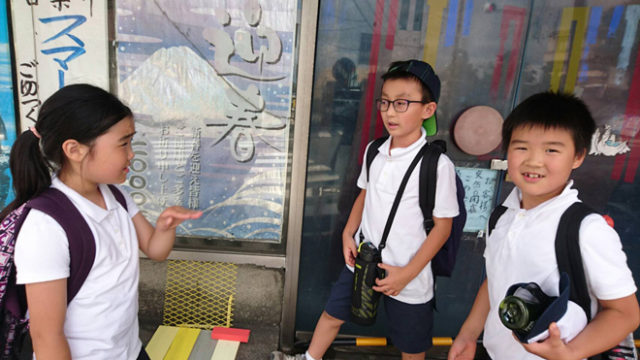By Taichi Yomida, Translated by Bruce Rutledge,
Three Japanese elementary school students who attend a local school here in Seattle used four days of their summer vacation to attend Atami Shiritsu Momoyama Elementary School in Shizuoka Prefecture. Those days were full of surprises for both the students who visited and the students who welcomed them.
Group life at school proves tough
The students who attended the school on July 11-14 were 4th grader Leah Fujita, her younger brother Koki in the second grade and 4th grader Ryu Hoshino of Seattle. All three study Japanese at the Seattle Japanese School on Saturdays, but they wanted to experience a Japanese school firsthand. For Leah and Koki, it was the second year in a row to do this. Momoyama is a school of 50 students 20 minutes up a hill from JR Atami Station. You can see the Pacific Ocean out the classroom windows. The school principal said, “We don’t want them to be treated as guests, but rather as children experiencing regular school life.” The students stayed with families in Atami, woke each morning at 6am, and commuted to school in the sweltering summer heat.
Going to school in groups, morning exercises, serving lunch and cleaning the classroom … none of these activities are done in Seattle schools. Older students offered to explain things. So the Seattle students asked how to properly squeeze the dustcloth and use the broom, and worked desperately to remember everything they were told. Momoyama Elementary has small class sizes. In gym class, students break up into groups of four. They were told to make up their own dances as music played. But the groups couldn’t make up their minds on a dance in the allotted 10 minutes. When the students met to review the class, they spoke up with comments like “There are lots of ideas, so it’s hard to gather them into one” and “It’s important to see the good parts of other people’s ideas.” Leah and Ryu didn’t give up; they raised their hands and offered their own opinions. Eventually, their group’s teamwork improved.
Stimulated by a different culture
The 4th grade class broke up into groups and used iPads to investigate Seattle. “Seattle is where Starbucks was born!” “There aren’t any in Atami, are there?” “It looks like it rains a lot. Atami wins the weather battle.” Leah and Ryu spoke proudly of Seattle as the class pondered the city across the ocean and comments flew this way and that. When an English website confused the Momoyama students, Leah immediately started reading it. The students’ eyes opened wide listening to the native speaker. When Leah and Ryu would speak English to each other on the way home from school, the other kids would perk up and ask, “What are you saying?” This encounter with students from a different culture stimulated them in many ways.
“Come back next year!” The funfilled four days were gone in the blink of an eye. The three students received letters on their last day and many of the
Japanese students said they would come to visit them in Seattle someday. Last year Leah said she wanted to move to Japan in the future. This year, she said, “I am going to put these letters under my pillow so I will always have sweet dreams.”
In the US, there aren’t that many opportunities to study Japanese, so students forget their kanji and vocabulary. That’s why there are many families who enter their children in Japanese schools during the summer. However, there is not an established way to apply for these opportunities; each school has its own criteria. Sometimes there aren’t enough teachers to accommodate more students, or the student doesn’t speak enough Japanese to get by, and many students get refused. Parents must search for schools willing to take their children. One parent told us, “For every 10 children who want to go, there are about three who actually get to.”
As fate would have it, this writer was able to go along with the three students and offer support for their school life. I was surprised at how these children from different environments went so quickly from feeling tense to making good friendships. It was a good experience for the Japanese students too. My hope is that more students in the US will choose to use their summer or winter vacations to enter a Japanese school.
Interview support: EN Pacific Service Inc.
Contact about the school experience in Japan: info@enpacificservice.com






